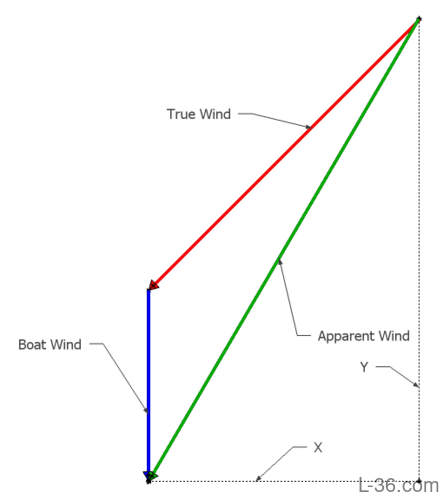Background -- Maximizing Speed to WindwardWithout Fancy Instruments
True and Apparent Wind
The wind you feel when you are sailing is the sum two winds. One is due to the "real" wind and is what you would feel if the boat was still. This is called the true wind (TW). The other is created by the motion of the boat. If the true wind suddenly stops and you are just coasting, the wind feels like it is directly in front of you and is equal to the boat speed (BS) but in the opposite direction to the motion of the boat. We will call that the boat wind. The apparent wind (AW) under sail is the sum of these two. When you are on a beat, the apparent wind angle is stronger than the true wind at an angle more toward the front of the boat. The math is a vector addition of the two winds. You don't need to know the math but I will present it below in case you are interested.
The Math (optional)
In the drawing to the left, the boat is traveling up on the page at 6 knots. That produces a boat wind pointing down of 6 knots and it is pictured in blue. The true wind is at 45 degrees to the motion of the boat at 12 knots it is in red. To add these two vectors, called vectors because they have a magnitude and a direction, we place them head to tail and draw a new vector from the tail of one vector to the head of the other. This is the apparent wind, the wind you feel, and it is in green.To find the length of the green vector, the apparent wind, we simply add the X and Y components of the red and blue vectors.
Starting with the X direction, the blue vector is zero so all we need is the X-component of the red vector. The angle of the red vector is 45 degrees but what do we do with it to get the X component? We can remember that we need to multiply it by a Sine or Cosine function of that angle. We also know that if the angle was 0, with the wind straight ahead, we would want to multiply it by 0 so we need the function that is 0 at 0 degrees, which is the Sine function. Therefore, the X component of the green vector is the magnitude of the true wind times the Sine of 45 degrees or AW(x) = TW * sin(45) or 8.5 knots
The Y direction takes the boat wind and adds the Y component of the true wind. In this case, we want the Sine or Cosine function that is 1 when the true wind angle is 0 so we want the Cosine function this time. AW(y) = BS + TW * Cosine(45). or 14.5 knots.
The final two steps are to find the magnitude and angle of the green vector. We can use the Pythagorean theorem to find the magnitude which says that the magnitude of the hypothenuse of a right triangle is the square root of the sum of the squares of the other sides. Square Root (8.5^2 + 14.5^2) = 16.8 knots.
To find the angle of the apparent wind (the green vector), we need to look a little carefully at our drawing and realize we want to solve for an angle that is zero when the green arrow is pointing directly down the page. That angle is the one at the top of the triangle formed by the green vector and the two dotted lines, its X and Y components. Trigonometry says that the tangent of that angle is X / Y so the angle is the inverse or the Arc tangent of X / Y or Arc tangent (8.5 / 14.5) or 30.4 degrees.
Simple!
My favorite proof of the Pythagorean theorem is HERE
| BACK | NEXT | Main Page |
NOTICE: Some pages have affiliate links to Amazon. As an Amazon Associate, I earn from qualifying purchases. Please read website Cookie, Privacy, and Disclamers by clicking HERE. To contact me click HERE. For my YouTube page click HERE